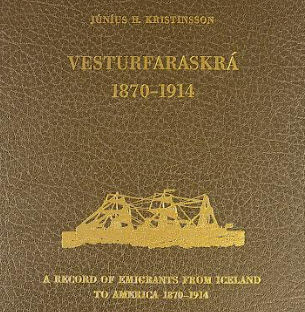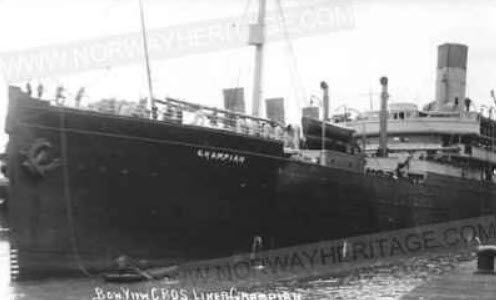The Emigration Variations
- Icelandic Roots

- Apr 16, 2023
- 4 min read
INTERESTING EMIGRATION VARIATIONS
By Dave Jonasson

You may have already read articles about mass emigrations from Iceland during the years 1870 to 1914. Vesturfarskrá documents 14,268 people who were recorded as leaving during that period. This was a large percentage of the people as the population of Iceland was 69,463 in 1870 and 87,137 in 1914. We can now report that ALL of the people listed in Vesturfarskrá are in our database and have an emigration event in their Icelandic Roots record. This accomplishment deserves a big THANK YOU to Icelandic Roots volunteers David Johnson and Willie Engelson for their multi-year effort. We are now working on finding passenger lists for Icelandic emigrants and attaching each page to the people listed on it. As a result of this effort as well as people previously identified in family histories, the number of emigrants we can enumerate is 17,862, and we are not finished yet!
Previous Icelandic Roots articles have documented a typical emigration journey; taking a smaller vessel from Iceland to the UK and then a second larger ship to Quebec City, Halifax, New York, or some other East Coast city. They also note exceptions, such as the two ships that went directly from Iceland to Quebec. The final emigration destination was often Manitoba or North Dakota, but there were many others, including Brazil, Utah, Nova Scotia, Washington Island, and Ontario.

As we were finding passenger lists and connecting people to them, we saw interesting emigration variations within a family. Yes, many families just emigrated, but:
Sometimes families emigrated on multiple ships. A husband, perhaps with an older son, might leave on one ship, followed by his wife and children on another. If the period between voyages was a few days or weeks, maybe they all could not obtain tickets on the same passage. But often, the period was a year or longer. It's likely that the first group left to "prepare the way" for the rest of the family to follow later.
On a voyage, you can sometimes see unrelated people on different tickets who subsequently marry after arriving in the new world.
Sometimes people were recorded as emigrating, and then they changed their mind and did not go, or died before they could leave, or perhaps were so sick that they had to leave the following year.
Sick children were sometimes left behind in Iceland and can be seen in later emigrations with a relative or neighbor.
Sometimes you can see young children on a manifest who were born after the family purchased their tickets to leave Iceland, or children born "at sea" during the passage, or children who were conceived during the passage!
Sometimes you see people on passenger lists who died during the crossing and were buried at sea.
Some people left Iceland, died during the stopover in Scotland, and can be seen buried there. Sometimes sickness in Scotland caused families to be listed on a manifest, then stricken off, and entered again on a later ship.
In later years, some emigrants were turned back by Canadian immigration officials in Scotland for medical reasons.
Other emigrants were examined by immigration officials in Canada only to be sent to the hospital at Grosse Isle, a quarantine station on an island in the St. Lawrence River.
Some emigrants settled in another country, often Norway or Denmark, and then later emigrated from there to North America.
Some emigrants settled in the Americas and then returned to Iceland after a few years. Sometimes they returned after staying decades, perhaps after the death of a spouse.
Sometimes they emigrated and then returned, only to emigrate again. At least one family emigrated this way THREE times.
Sometimes emigrants returned to Iceland so that they could accompany an aging relative or love interest on their emigration.
Later in the emigration period, it was harder to identify true “emigrants." We find students, businessmen, and diplomats who left Iceland temporarily; some return as planned, but others ended up staying. As we expand the emigration years of interest, we now see tourists (from North America and from Iceland); and war brides, sometimes with children, following or accompanying their servicemen husbands.
Working with passenger lists has been an interesting journey. In future articles, we hope to highlight more families, such as F55093. This family also illustrates the difficulty in 'counting' emigrants!
Their story goes as follows:
Hjalti Sigurðson / Anderson (I# 179130) emigrated as an 11-year-old "taken-in-child" in July 1887. He left from Akureryi, ultimately arriving in Quebec on the SS Buenos Ayrean.

Guðrún Bergþórsdóttir / Johnson (I# 179330) emigrates with her mother and three younger siblings from Norður-Ísafarðarsýsla on the ship Copeland, arriving in Quebec on the SS Norwegian on July 8th, 1888. Her father and an adopted brother emigrated a year earlier and may have been preparing for the rest of their family to arrive.

Hjalti and Guðrún marry in Brandon, Manitoba, on September 19th, 1894, and had five children there.
In 1904, Hjalti goes on a trip to Iceland, returning to Canada to take his wife and five children to Reykjavik in October 1905. Hjalti plans to go into business there with his merchant brother, Ásgeir.
In Iceland, the couple have two more children.
In 1910, the couple and their seven children emigrate to Scotland, where they have another child.
Hjalti returns to the Americas around 1912. His wife and their eight children are seen returning on the RMS Grampian in October 1913. They may have lived in Canada briefly, as Guðrún is seen crossing from Ottawa to Rochester, New York, in December 1916.

The couple and their children ultimately reside in Chicago and later Los Angeles, as seen on the 1920, 1930, and 1940 census records.
Not only does this family illustrate the many different situations we genealogists sometimes stumble upon, but also the difficulty in "counting" emigrations. Here we have two original Icelanders, five children born in Canada who leave and later return, and three other children who arrive in Canada but were born in Iceland and Scotland.



